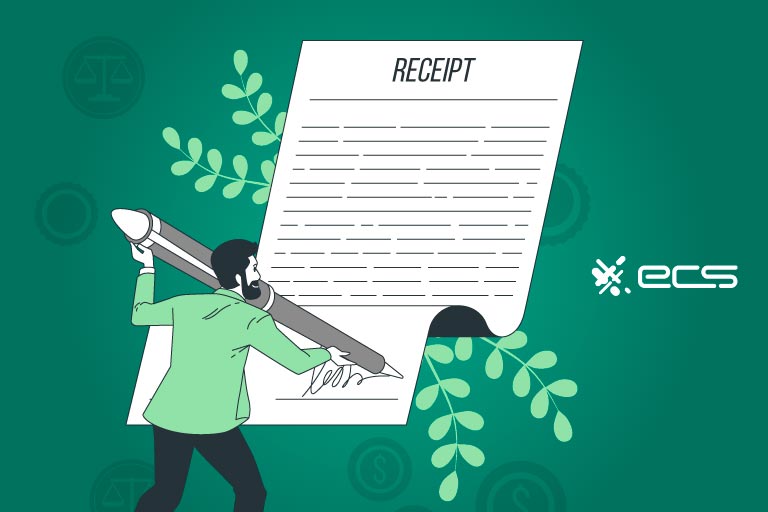It used to be that every time a customer made a purchase with a credit card, merchants would require a signature on the printed receipt. However, have you noticed that this step of the transaction process -signing credit card receipts- rarely happens today?
Signatures were the key to authorizing a credit card transaction. Although most can agree, signatures are not a highly reliable method for preventing fraudulent and unauthorized transactions.
So, what triggered the change? Similar to everything else, you can give credit to technological advancements.
This article is designed for merchants and customers who have interest in learning if signing credit card receipts is still required, and why some merchants request it, while others do not.
What Are Credit Card Receipts?
Credit card receipts are proof of a completed transaction. Merchants can either print them out on thermal paper, printer paper, or electronically deliver them via email or text message- all from their POS system. A receipt will provide the details of a transaction.
What Information Does a Credit Card Receipt Detail?
As a part of fraud prevention, the Fair and Accurate Credit Transactions Act requires specific information to be on credit card receipts.
The card’s primary account number (PAN): A PAN is not a full credit card number, but rather a condensed version or the last four digits of the full number.
Transaction data: Transaction information includes the total transaction amount, the transaction time and time date, and in most cases an itemization of all items purchased along with its price.
Merchant information: The merchant’s name, their address, and their merchant ID (MID) not only helps customers understand where the receipt is from but also informs the merchant’s payment processor where to deposit the funds from the transaction.
Authorization code: The authorization code is a 4 to 6-digit code from the credit card company that is proof of approval for the transaction. It is validating that the cardholder has the available funds to successfully complete the purchase.

What Was the Purpose Of Credit Card Signatures?
If a credit card transaction is accompanied by an authorization code from the credit card company, then what is the purpose of the signature to also approve the transaction?
Well, the credit card companies actually required signatures as a prevention strategy for fraud. It was also a safety measure for themselves to prove whether a transaction was valid or not. Merchants would always ask a customer to sign at the bottom of the merchant’s receipt copy. Then they would store it for future use if need be.
Meaning, if a customer were to dispute a transaction on their credit card, the merchant could use the signature to prove that the cardholder did or did not issue authorization for the purchase. If there is a valid signature on a receipt of purchase, it proves that the cardholder was in the merchant’s location and authorized the transaction in person.
If merchants did not acquire proof of authorization, they would be at fault for chargeback losses. Moreover, not only would they be at fault for no valid signature, but a mismatched signature as well. Meaning, the signature on the receipt did not match the one on the back of the card or the cardholder’s ID.
How To Verify Signatures For Credit Card Transactions
The signature panel on the back of credit cards is intended for merchants to verify and match the receipt signature. Some cardholders sign while others write “see ID”, and yet some still don’t bother to do either. Leaving the box blank and themselves more vulnerable to fraudulent purchases should they ever lose possession of their card.
Merchants should check the back of the card or the cardholder’s ID. If they see that the signatures do not match, then they can cancel the sale. While a merchant may want to complete the sale, they ultimately would be doing themselves a disservice. Should the true cardholder file a chargeback and the merchant have no evidence to prove the validity of the transaction, they would be at a loss.
However, over time, as customers were able to swipe their own cards into card readers rather than hand them over to the cashiers, the practice of asking for the card to verify signatures has faded out. Leaving more room for fraud.
Technological Advancement
For credit card companies to expect cashiers to add “handwriting analyst” to their resumes proved unreasonable and made for an unsecure checkout process. And with the influx of eCommerce shopping, signature verification quite literally became impossible.
However, Thanks to technological advancements, and improved security features the credit card companies began to loosen their signature requirements. For example, by 2012, Mastercard stopped requiring signatures on purchases that were under $50. By 2018, collecting signatures on credit card receipts was no longer a requirement from all four of the card brands.
The implementation of security features to prevent credit card fraud includes:

Electronic Card Readers
Back in the day, when credit card payments began, merchants would emboss card numbers onto paper. They they would run the transactions manually or verify them later in the day by phone with the credit card companies. There was no electronic transmission providing an authorization code, proving the validity of the card, the available funds, or even a decline code if the card had been reported lost or stolen.
But now, with electronic card readers, all these things are possible. In an instant, financial institutions such as credit card networks, issuing banks, and payment processors all work together to authenticate a transaction in as little as 3 seconds.
CVV
The card verification value (CVV) was implemented as an additional security feature for card-not-present transactions such as online or over the phone. It is a 3-digit number on the back of the card. Unless American Express issued the card, then it has 4 digits and remains on the front of the card.
The purpose of the CVV is to verify that the customer is holding the physical card in their hand while attempting to make the purchase. Conversely, if the card number was stolen by means such as virtual fraud, the CVV may not have made its way into the fraudster’s database.
This is not to say that if someone’s card was physically stolen, they wouldn’t have access to the CVV. Of course they would. It is printed directly onto the card. So cardholders need to be careful that they’re in possession of their credit cards or that they are securely stored at all times, to prevent fraud or the headache of having to issue a chargeback of an unauthorized purchase.
EMV Chips
In 2015, EMV cards were introduced to the market. Europay, Mastercard, and Visa (EMV) created the global security standards that credit and debit cards must adhere to with chip technology.
By 2018, the four main credit card companies (Mastercard, Visa, American Express, and Discover) allowed EMV-compliant merchants to use a signature-free checkout. The big-box retailers such as Walmart, Costco, Lowe’s, Best Buy, etc, praised the decision. Because a speedier checkout process means happier clients and ultimately higher sales.
Unfortunately, merchants who were not up to standard with EMV technology would incur greater liability for fraudulent transactions. EMV technology laid the groundwork to move away from requiring credit card signatures at the point of sale.
How Does EMV Chip Security Work?
When cardholders insert their chip into a card terminal, they will see a message on the screen that displays “do not remove card.” During that time, the card’s chip is transmitting a message to the credit card network. It then waits for a reply with a one-time-only authentication code. Once the card is authenticated, the cardholder may remove their card.
If hackers gain access to transaction information and the credit card number, or if a data breach occurs, future purchases would decline the information as the one-time-only code would no longer be valid. The encryption prevents the data from being reused and would notify the EMV technology of the scam.

Should Merchants Keep Credit Card Receipts?
In short, yes. There are several reasons it would be advantageous for a business to keep credit card receipts.
- For taxes: The IRS advises merchants to keep all records including receipts for at least three years. This includes records for both income and expenses.
- For chargebacks: Should a customer issue a chargeback on a transaction, the receipt is one of the merchant’s tools for proving the validity of the purchase.
- For statements: Receipt records can help merchants to help prepare monthly, quarterly, or yearly financial statements.
- For managing finances: Receipts help to reconcile income versus expenses, manage inventory, and budget accordingly for future business decisions.
So, Should Your Business Quit Asking its Customers to Sign Credit Card Receipts?
Most large retailers have stopped requiring credit card signatures following the card network’s announcement in 2018. However, some smaller merchants have continued to collect receipt signatures on both credit and debit card transactions.
Before deciding which of these routes it best for your business, consider some of the following factors:
Is Your Business’s Point-of-Sale EMV Compliant?
Nearly 90% of in-store transactions use EMV, today. However, only about 75% of merchants in the US have adopted EMV-compliant technology at the point of sale. If you are a part of the 25% of merchants who have yet to do so, you will still need to ask for a signed receipt at checkout.
EMV technology allows merchants to stop collecting signed receipts, in addition to giving merchants better peace of mind as it provides anti-fraud measures. In fact, Visa’s most updated records report that merchants with EMV-compliant terminals have seen a 76% decrease in counterfeit fraud.
If you are ready to update your point-of-sale to EMV-compliant hardware, you can reach out to ECS Payments for information on what solutions we have to best meet your needs.

Does Your POS System Offer Disabled Signature Options For Payments?
Next, If you have updated your payment technology to EMV-compliant card terminals, you now need to be sure the software is up-to-date to remove or customize the signature step of the checkout.
Many payment systems allow merchants to choose whether or not they want to require signed receipts. Better yet, with the right terminal, a merchant will have options for receipt signatures. Such as always requiring receipt signatures, or never requiring receipt signatures, or only requiring receipt signatures for transactions that are over a certain amount.
Does Your Business Use Customer Signatures On Invoices and Approval Proof?
Your business may use receipt signatures for purposes other than a sales slip. Such as to gain proof of customer approval for a sales policy, a work order, or an itemized contract of estimated costs.
Invoice signature required sections provide an extra layer of protection against fraud or chargebacks. By ensuring that you have a signed invoice, you will have a record of their agreement to pay and their approval of your terms.
Is Your Business Prone To Credit Card Fraud or Chargebacks?
Merchants who have decided to adopt EMV-compliant technology should be far less concerned about chargebacks or credit card fraud. If your business is susceptible to fraudulent purchases or a high chargeback ratio, it’s definitely time to look into EMV-compliant technology.
EMV chip cards use secure encryption and are nearly impossible to duplicate, unlike the borderline obsolete magnetic-stripe cards. This increases authentic transactions and reduces fraudulent transactions. Resulting in less liability concerning chargebacks for merchants.
What About Signatures for Proof of Delivery?
If your business meets all of the above criteria and you’re ready to adopt EMV-compliant hardware, you may be wondering, what about signature required services such as shipping goods? Should the customer still sign for the package delivery?
Well, the truth of the matter is there is no entity that determines the rules of engagement for merchant deliveries. Paying and actually receiving the goods are different cases. You may choose whether the delivery service can just drop off at the delivery address or require a signature to accept the delivery.
Even if the customer isn’t home, you could determine that an indirect signature is required. Especially if: this is an expensive item
- the neighborhood is prone to porch pirates,
- or if your business is susceptible to chargebacks.
- FedEx delivery manager is also another great tool that merchants can suggest their clients use to track their packages if this is the delivery service they are using for shipments.

Why Do Some Merchants Still Require Signing Credit Card Receipts?
Though the card brands are no longer requiring signatures for EMV-compliant merchants, some are still asking for them at checkout. Below are a few reasons why merchants are still requiring signatures for credit card transactions.
Merchants Aren’t Aware of the Change
The first reason could be as simple as ignorance. Merchants may not be up-to-date on the dos and don’t of credit card processing. Especially if they have been in business for many years and are stuck in their old ways.
So, if this is news to you, let us be the first to provide you with the good news. There are no legally binding terms on your merchant processing agreement about signing credit card receipts. So, you no longer need to obtain a signature from your customers for their credit card transactions. Regardless of the dollar amount.
Some Business Types Require Signatures
As we mentioned above, some merchants may need signatures due to the type of business they provide. This can include the restaurant industry due to the manual tip entry after running the card. Service providers such as contractors, plumbers, handymen may also need signed invoices for their services. And merchants who have a set contract or terms of service may also need a signature to protect themselves legally.
The Need For Hardware Updates
Lastly, as we also mentioned above, a merchant simply may not have yet committed to adopting up-to-date equipment or software. Older terminals and software are programmed to always ask for a signature for credit card transactions.
If this is the case for you, contact ECS payments or whomever you process with to see if your terminals can be reprogrammed or to see what updated point-of-sale equipment would be best for your unique needs.
Though new equipment may cost your business some money, it can also offer other cool perks such as easy-to-use interfaces, and business tools such as analytics, inventory, CRMs, and more.
What Does All Of This Mean for Your Small Business?
Though signing credit card receipts is now optional if you have an EMV-compliant credit card reader, EMV-compliant checkout carries many benefits. EMV transactions help to reduce credit card fraud, create faster checkout experiences, reduce merchant liability for chargebacks and fraud, include contactless payments, and improve customer trust.
Overall, EMV technology benefits both merchants and consumers. If you’re ready to upgrade your point-of-sale, contact ECS Payment Sales for more information.
